| Women of Note in New Orleans History |
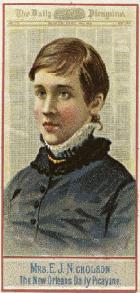
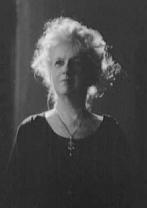
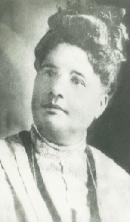
Dr. Elizabeth Magnus Cohen, pictured above, was the first women who
practiced medicine in Louisiana (and one of the first in the South). She
cared for the people of New Orleans' French Quarter from 1857 to 1887,
a time when Yellow Fever, Typhoid and Smallpox regularly ravaged the
population. She was considered a leading surgeon in the city and
claimed never to have lost a patient on the operating table. She died in
1921 at the age of 101.
Elizabeth Lyle Saxon, born 1832, and Caroline E. Merrick, born 1825,
worked together as pioneer suffragists and social reformers who were
known nation-wide. At the 1879 LA Constitutional Convention, Saxon
and Merrick petitioned delegates to give all women the right to vote. It
was the first time women spoke before a state body on behalf of
women's rights and can be considered the start of the women's
movement in Louisiana. They spoke before the U.S. Senate Judiciary
Committee on behalf of a constitutional amendment for women's
suffrage and they toured the country with Susan B. Anthony to advance
the movement. All the while, they continued involving themselves in
social and civic activism in New Orleans. Elizabeth Saxon was, also, a
poet and author and the grandmother of noted New Orleans writer and
architectural preservationist, Lyle Saxon.
practiced medicine in Louisiana (and one of the first in the South). She
cared for the people of New Orleans' French Quarter from 1857 to 1887,
a time when Yellow Fever, Typhoid and Smallpox regularly ravaged the
population. She was considered a leading surgeon in the city and
claimed never to have lost a patient on the operating table. She died in
1921 at the age of 101.
Elizabeth Lyle Saxon, born 1832, and Caroline E. Merrick, born 1825,
worked together as pioneer suffragists and social reformers who were
known nation-wide. At the 1879 LA Constitutional Convention, Saxon
and Merrick petitioned delegates to give all women the right to vote. It
was the first time women spoke before a state body on behalf of
women's rights and can be considered the start of the women's
movement in Louisiana. They spoke before the U.S. Senate Judiciary
Committee on behalf of a constitutional amendment for women's
suffrage and they toured the country with Susan B. Anthony to advance
the movement. All the while, they continued involving themselves in
social and civic activism in New Orleans. Elizabeth Saxon was, also, a
poet and author and the grandmother of noted New Orleans writer and
architectural preservationist, Lyle Saxon.
Eliza Jane Poitevent Holbrook Nicholson, pictured above, who wrote
under the nom de plume Pearl Rivers, was a poet, columnist, newspaper
editor and publisher. Born in Mississippi in 1843, she moved to New
Orleans as a young woman and was the first woman in Louisiana to earn
a living writing for a newspaper and the first woman owner of a major
newspaper. Upon inheriting the Daily Picayune, she helped save it from
failing and turned it into a successful venture. She was a social
advocate for education, children's health and against cruelty to animals.
Justine Fervin Couvent, known as la Veuve Couvent (the Widow
Couvent), was a former slave, born in Africa in the 1750's. She became
a benefactress of education and orphans. She founded a school in New
Orleans for orphans of free people of color - an institution unique at the
time of its establishment - and left her considerable estate to the school
upon her death in 1837. The school survived for many years.
Margaret Gaffney Haughery was born in Ireland in 1814. She lost her
husband and baby to Yellow Fever not long after arriving in New
Orleans. The businesses she established in the city became successful
and she used the proceeds from and the products of her dairy and
bakery to provide for people in need. During the Yellow Fever
epidemics, she went from house to house, without regard to race or
religion, nursing and consoling the victims. She ultimately supported
as many as seven orphanages. She left her estate to the orphanages of
New Orleans. She was the first woman in the U.S. to have a statue
erected in her honor.
Dr. Linda Coleman was the first woman to graduate from Tulane
University's Medical School in 1917, becoming the first woman to
graduate from a medical school in Louisiana. Fannie R. Glover, in 1911,
was the first woman to graduate from a New Orleans nursing school.
Eliza Rudolph was the first licensed woman pharmacist in Louisiana; in
1882, she was the first woman accepted into the state pharmaceutical
association.
under the nom de plume Pearl Rivers, was a poet, columnist, newspaper
editor and publisher. Born in Mississippi in 1843, she moved to New
Orleans as a young woman and was the first woman in Louisiana to earn
a living writing for a newspaper and the first woman owner of a major
newspaper. Upon inheriting the Daily Picayune, she helped save it from
failing and turned it into a successful venture. She was a social
advocate for education, children's health and against cruelty to animals.
Justine Fervin Couvent, known as la Veuve Couvent (the Widow
Couvent), was a former slave, born in Africa in the 1750's. She became
a benefactress of education and orphans. She founded a school in New
Orleans for orphans of free people of color - an institution unique at the
time of its establishment - and left her considerable estate to the school
upon her death in 1837. The school survived for many years.
Margaret Gaffney Haughery was born in Ireland in 1814. She lost her
husband and baby to Yellow Fever not long after arriving in New
Orleans. The businesses she established in the city became successful
and she used the proceeds from and the products of her dairy and
bakery to provide for people in need. During the Yellow Fever
epidemics, she went from house to house, without regard to race or
religion, nursing and consoling the victims. She ultimately supported
as many as seven orphanages. She left her estate to the orphanages of
New Orleans. She was the first woman in the U.S. to have a statue
erected in her honor.
Dr. Linda Coleman was the first woman to graduate from Tulane
University's Medical School in 1917, becoming the first woman to
graduate from a medical school in Louisiana. Fannie R. Glover, in 1911,
was the first woman to graduate from a New Orleans nursing school.
Eliza Rudolph was the first licensed woman pharmacist in Louisiana; in
1882, she was the first woman accepted into the state pharmaceutical
association.
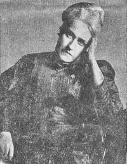
Sophie Bell Wright, pictured above, was one of the most important
educators, civic leaders and social reformers of her time. She
established educational programs for women and the poor, she worked
tirelessly on behalf of Yellow Fever victims, terminally ill patients and
prison reform efforts; and she was responsible for the establishment of
many of the city's first playgrounds. Ms. Wright was a recipient of the
Daily Picayune's Loving Cup award and, in 1912, she became the first
living New Orleanian to have a school named after her - the first girls'
high school in the city. The school remains open today.
Eleanor Laura McMain was internationally known for her work in the
settlement house movement. She was instrumental in shaping Kingsley
House - which remains a vital part of the community today - into a model
of excellence in the field of social work. Ms. McMain gained fame as
one of the preeminent social workers in the U.S. She helped establish
the Tulane School of Social Work, which was instituted at Kingsley
House in 1921 and is the fifth oldest school of social work in the
country. She taught sociology at Sophie Newcomb College and, in 1923,
was chosen to organize a settlement house, the l'Acceuil
Franco-American, in Paris. She was awarded the Picayune's Loving Cup
in 1920 and a New Orleans public school was named in her honor. The
school remains open today.
Louise Simon Davis founded the Magnolia School in 1935, the first
school for the mentally disabled in New Orleans. She was a pioneer in
education for the mentally disabled and a social activist. She, also,
founded two schools for African-American students and worked with
Eleanor McMain at Kingsley House.
Nell Pomeroy O'Brien was a well-known artist and art teacher whose
posters were used by the U.S. War Dept. in WWI. She was known
primarily for her portrait and flower paintings, which were exhibited all
over the country. She did volunteer work for dozens of New Orleans
civic organizations.
educators, civic leaders and social reformers of her time. She
established educational programs for women and the poor, she worked
tirelessly on behalf of Yellow Fever victims, terminally ill patients and
prison reform efforts; and she was responsible for the establishment of
many of the city's first playgrounds. Ms. Wright was a recipient of the
Daily Picayune's Loving Cup award and, in 1912, she became the first
living New Orleanian to have a school named after her - the first girls'
high school in the city. The school remains open today.
Eleanor Laura McMain was internationally known for her work in the
settlement house movement. She was instrumental in shaping Kingsley
House - which remains a vital part of the community today - into a model
of excellence in the field of social work. Ms. McMain gained fame as
one of the preeminent social workers in the U.S. She helped establish
the Tulane School of Social Work, which was instituted at Kingsley
House in 1921 and is the fifth oldest school of social work in the
country. She taught sociology at Sophie Newcomb College and, in 1923,
was chosen to organize a settlement house, the l'Acceuil
Franco-American, in Paris. She was awarded the Picayune's Loving Cup
in 1920 and a New Orleans public school was named in her honor. The
school remains open today.
Louise Simon Davis founded the Magnolia School in 1935, the first
school for the mentally disabled in New Orleans. She was a pioneer in
education for the mentally disabled and a social activist. She, also,
founded two schools for African-American students and worked with
Eleanor McMain at Kingsley House.
Nell Pomeroy O'Brien was a well-known artist and art teacher whose
posters were used by the U.S. War Dept. in WWI. She was known
primarily for her portrait and flower paintings, which were exhibited all
over the country. She did volunteer work for dozens of New Orleans
civic organizations.
Frances Gaudet, pictured above, was born in 1861 of African-American
and Native-American heritage. She was a nationally respected social
reformer and prisoner-rights activist. She dedicated her life to social
work. She attended court hearings and assumed responsibility for
youngsters arrested for misdemeanors and worked toward their
reform. Mrs. Gaudet was the first woman to support juvenile prisoners
in Louisiana and her efforts helped found the Juvenile Court. She
established the Gaudet Normal and Industrial School (later known as
the Gaudet Episcopal Home) on Gentilly Road. In 1921, Mrs. Gaudet
deeded the school to the Protestant Episcopal Church. The school is
no longer open, but the endowment continues to fund St. Luke's
Community Center, which still honors Mrs. Gaudet's memory.
Dr. Sara Tew Mayo was the driving force behind the establishment of
the New Orleans Hospital and Dispensary for Women and Children. It
was later renamed Sara Mayo Hospital. Dr. Mayo received the Daily
Picayune's Loving Cup award in 1910 (presented annually to the citizen
deemed to have contributed most toward social activism and
philanthropy). The hospital remained open for many years and there is
still a neighborhood health care clinic named in honor of Dr. Mayo. I
believe the old hospital on Jackson Avenue has been turned into
condominiums.
Bettie Runnels was the first woman to be admitted to Tulane University
and, in 1898, the first woman to receive a law degree from a Louisiana
university.
Jean Gordon was appointed to be the first woman factory inspector in
New Orleans in 1907 (inspections regarding child labor). She was a
noted suffragist and social activist and she was responsible, in large
measure, for the passage of child labor laws in the South.
and Native-American heritage. She was a nationally respected social
reformer and prisoner-rights activist. She dedicated her life to social
work. She attended court hearings and assumed responsibility for
youngsters arrested for misdemeanors and worked toward their
reform. Mrs. Gaudet was the first woman to support juvenile prisoners
in Louisiana and her efforts helped found the Juvenile Court. She
established the Gaudet Normal and Industrial School (later known as
the Gaudet Episcopal Home) on Gentilly Road. In 1921, Mrs. Gaudet
deeded the school to the Protestant Episcopal Church. The school is
no longer open, but the endowment continues to fund St. Luke's
Community Center, which still honors Mrs. Gaudet's memory.
Dr. Sara Tew Mayo was the driving force behind the establishment of
the New Orleans Hospital and Dispensary for Women and Children. It
was later renamed Sara Mayo Hospital. Dr. Mayo received the Daily
Picayune's Loving Cup award in 1910 (presented annually to the citizen
deemed to have contributed most toward social activism and
philanthropy). The hospital remained open for many years and there is
still a neighborhood health care clinic named in honor of Dr. Mayo. I
believe the old hospital on Jackson Avenue has been turned into
condominiums.
Bettie Runnels was the first woman to be admitted to Tulane University
and, in 1898, the first woman to receive a law degree from a Louisiana
university.
Jean Gordon was appointed to be the first woman factory inspector in
New Orleans in 1907 (inspections regarding child labor). She was a
noted suffragist and social activist and she was responsible, in large
measure, for the passage of child labor laws in the South.
Grace Elizabeth King, pictured above, was a celebrated author and
historian whose books on New Orleans and Louisiana history achieved
national attention. She was one of the few Southern writers of her time
to achieve national recognition in both fiction and history. Ms. KIng
lectured at Newnham College, Cambridge, England during one of her
trips to Europe. She received an honorary Doctor of Letters degree
from Tulane University and was awarded the Palmes d'Officier de
l'Instruction Publique by the French government. In 1923, she was
honored for her outstanding work by the Louisiana Historical Society. A
public high school in Jefferson Parish was named in her honor.
Alice Almira Boley was born in 1890, the grandchild of a former slave.
She was a noted academic who made significant contributions to the
development of Southern University. She was an instructor at the
university until 1942, as well as, Principal of the Southern University
Laboratory School. There is a hall at the school named in her honor.
Eve Butterworth Dibert was a New Orleans philanthropist and the first
non-Catholic woman to receive the Merenti Medal, a papal award. She
received the Daily Picayune's Loving Cup award in 1917. The John
Dibert Tuberculosis Hospital was founded by Mrs. Dibert in memory of
her husband. She contributed over $2 million dollars to various worthy
causes, including Charity Hospital, Sisters of Charity's Hope Haven,
Hotel Dieu Hospital, St. Andrew's Episcopal Church and John Dibert
Public School. John Dibert Elementary School remains open today.
Marion Pfeifer Abramson was a civic leader and the founder of WYES
educational TV station in New Orleans. She was active in education and
in politics and involved in many civic causes. Abramson High School,
which was named in her honor, is now a charter school.
historian whose books on New Orleans and Louisiana history achieved
national attention. She was one of the few Southern writers of her time
to achieve national recognition in both fiction and history. Ms. KIng
lectured at Newnham College, Cambridge, England during one of her
trips to Europe. She received an honorary Doctor of Letters degree
from Tulane University and was awarded the Palmes d'Officier de
l'Instruction Publique by the French government. In 1923, she was
honored for her outstanding work by the Louisiana Historical Society. A
public high school in Jefferson Parish was named in her honor.
Alice Almira Boley was born in 1890, the grandchild of a former slave.
She was a noted academic who made significant contributions to the
development of Southern University. She was an instructor at the
university until 1942, as well as, Principal of the Southern University
Laboratory School. There is a hall at the school named in her honor.
Eve Butterworth Dibert was a New Orleans philanthropist and the first
non-Catholic woman to receive the Merenti Medal, a papal award. She
received the Daily Picayune's Loving Cup award in 1917. The John
Dibert Tuberculosis Hospital was founded by Mrs. Dibert in memory of
her husband. She contributed over $2 million dollars to various worthy
causes, including Charity Hospital, Sisters of Charity's Hope Haven,
Hotel Dieu Hospital, St. Andrew's Episcopal Church and John Dibert
Public School. John Dibert Elementary School remains open today.
Marion Pfeifer Abramson was a civic leader and the founder of WYES
educational TV station in New Orleans. She was active in education and
in politics and involved in many civic causes. Abramson High School,
which was named in her honor, is now a charter school.
Sister Xavier's Herb Garden Margaret Haugherty: The Bread Lady of New Orleans Sophie B. Wright School Back to Old New Orleans Whispers - Home |
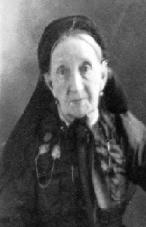
In 1727, twelve Ursuline nuns arrived in New Orleans from France.
They provided badly needed medical care and established an
orphanage and a school. Since that time, the Ursuline nuns, and the
other orders that followed, have been an unfailing force for good in the
community. They set a high standard for the women who would come
after them - a standard of courage, leadership, perseverance and
fidelity to good causes. It was a standard that, fortunately for the city
and beyond, many women throughout New Orleans' history would
enthusiastically meet.
Sister Francis Xavier Hebert was one of the twelve Ursuline nuns who
came to the city in 1727. She immediately set to work to create an herb
garden. From the Old Ursuline Convent Cookbook: "Sister Xavier
compounded the medicines for the Royal Hospital and became the first
woman pharmacist in the New World. The teas, infusions and distillates
which she brewed from the herbs in her garden represented the
greater part of what was available for the treatment of the sick. In
colonial times...the herb garden was vital in providing medicines...
Sister Xavier's herb garden became critically important to the lives of
the people of New Orleans."
They provided badly needed medical care and established an
orphanage and a school. Since that time, the Ursuline nuns, and the
other orders that followed, have been an unfailing force for good in the
community. They set a high standard for the women who would come
after them - a standard of courage, leadership, perseverance and
fidelity to good causes. It was a standard that, fortunately for the city
and beyond, many women throughout New Orleans' history would
enthusiastically meet.
Sister Francis Xavier Hebert was one of the twelve Ursuline nuns who
came to the city in 1727. She immediately set to work to create an herb
garden. From the Old Ursuline Convent Cookbook: "Sister Xavier
compounded the medicines for the Royal Hospital and became the first
woman pharmacist in the New World. The teas, infusions and distillates
which she brewed from the herbs in her garden represented the
greater part of what was available for the treatment of the sick. In
colonial times...the herb garden was vital in providing medicines...
Sister Xavier's herb garden became critically important to the lives of
the people of New Orleans."